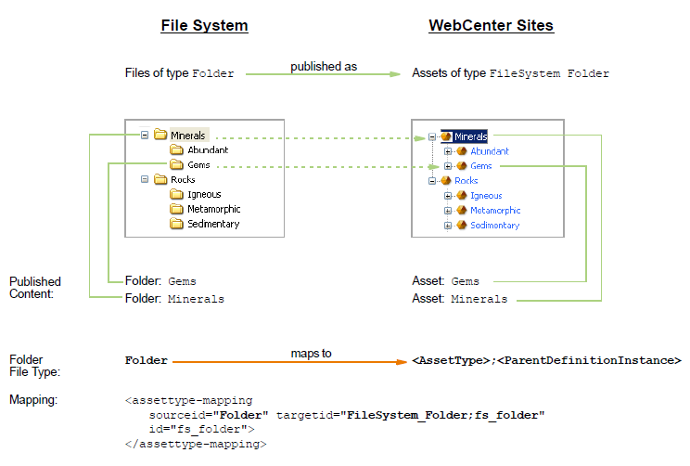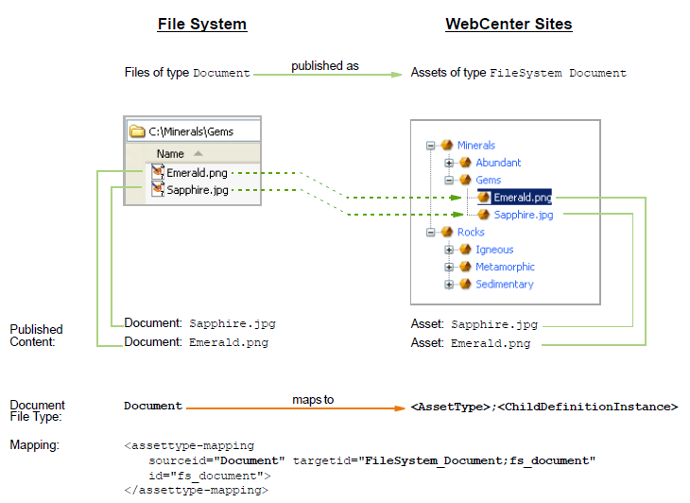60 File Systems: Default Mapping Specifications
The default mapping framework in the Content Integration Platform enables publishing from file systems, as long as the publishable content is based on the following default constructs of the file system: Folder and Document file types, and attributes contentAttr , contentURL , and FileSize.
This chapter contains the following sections:
60.1 Overview
The mapping framework supplies the following default components:
-
The
FileSystemflex family, pre-configured to match the file types and attributes listed above. -
A
mappings.xmlfile, in which file types and attributes (listed above) are mapped to assets in theFileSystemflex family:-
The
Folder filetype is mapped to a flex parent definition asset namedfs_folder. -
The
Document filetype is mapped to a flex definition asset namedfs_document. -
Attributes are mapped to flex assets of type FileSystem Attribute.
-
The mapping is coded in mappings.xml, and summarized in Table 60-1, "FileSystem Default Data and Flex Family Analogs" (for more information, see Section 60.2, "Default mappings.xml").
Once the mapping is established, folders of type Folder (and their contents) can be published:
-
Folders are published as flex parent assets to the
FileSystem Folderasset type. -
Documents are published as flex assets to the
FileSystem Documentasset type.
During publishing, the Content Integration Platform refers to the mappings.xml file to determine the types of objects to publish (Folder and Document). The folder that is named in the publish command is the starting point of the publication process. The folder is published as a flex parent asset of the FileSystem Folder, along with all the subfolders and documents it contains.
To reproduce the folder's structure, (subfolders and documents), the Content Integration Platform refers to path information. If subfolders exist, the Content Integration Platform chains their counterpart Filesystem Folder assets to reproduce the heirarchy. Documents, treated as flex assets of file type FileSystem Document, are placed under their respective FileSystem Folder parent assets.
Figure 60-1 Mapping the Document Type to the FileSystem Flex Family

Description of ''Figure 60-1 Mapping the Document Type to the FileSystem Flex Family''
Figure 60-2 Mapping the Document Type to the FileSystem Flex Family

Description of ''Figure 60-2 Mapping the Document Type to the FileSystem Flex Family''
60.2 Default mappings.xml
The default mappings.xml file, located in the Content Integration Agent, maps the file system's default schema to WebCenter Sites' FileSystem flex family. The mapping is uniquely identified by the id attribute, specifically in this example as <mapping id="filesystem2cs">. Parameters for the <assettype-mapping> and <descriptor-mapping> tags are defined in "Tags and Parameters for Mapping File System Data to Oracle WebCenter Sites".
<mappings>
<!-- File System to CS -->
<mapping id="filesystem2cs">
<assettype-mapping
sourceid="Document"
targetid="FileSystem_Document;fs_document"
id="fs_document">
<descriptor-mapping
sourceid="contentAttr"
targetid="file" type="static" />
<descriptor-mapping
sourceid="contentURL"
targetid="contentURL" type="dynamic" />
<descriptor-mapping
sourceid="FileSize"
targetid="file_size" />
</assettype-mapping>
<assettype-mapping
sourceid="Folder"
targetid="FileSystem_Folder;fs_folder"
id="fs_folder" />
</mapping>
</mappings>
60.3 FileSystem Flex Family Specifications
Table 60-1, "FileSystem Default Data and Flex Family Analogs" summarizes the default mapping of file system schema to WebCenter Sites' FileSystem flex family. For customized implementations, you can either re-use the flex family or create your own.
Table 60-1 FileSystem Default Data and Flex Family Analogs
| Type of Data | File System Default Data | Maps To FlexAssetType | Maps to Flex Family Member | Description | Assets of This Type Are Created By |
|---|---|---|---|---|---|
|
Schema |
Attribute Attributes (for documents)Foot 1 :
|
FileSystem Attribute Stores attribute instances:Foot 2
|
Flex Attribute |
This flex asset type stores attributes for documents. |
WebCenter Sites Administrator |
|
Schema |
Folder File Type
|
FileSystem Parent Definition Stores parent definition instance: Foot 3
|
Flex Parent Definition |
This flex asset type stores parent definition instances. |
WebCenter Sites Administrator |
|
Schema |
Document File Type |
FileSystem Child DefinitionStores child definition instance:
|
Flex (Child) Definition |
This flex asset type stores child definition instances. |
WebCenter Sites Administrator |
|
Content |
Published Folders Folders of file type
|
FileSystem Folder Stores flex parent assets (of type |
Flex Parent |
This flex asset type stores folder assets. |
Content Integration Platform |
|
Content |
Published Documents Documents of file type
|
FileSystem Document Stores flex (child) assets (of type |
Flex (Child) Asset |
This flex asset type stores document assets. For an example, see Figure 60-1. |
Content Integration Platform |
Footnote 1 Attribute names are display names. The less commonly used system-defined attributes have been omitted from the default mappings.xml file and flex family. The attributes are: DateCreated, DateModified, MimeType.
Footnote 2 "Instance" means "asset." "Instance" is used only to help differentiate metadata (instances) from published content (assets).
Footnote 3 "Instance" means "asset." "Instance" is used only to help differentiate metadata (instances) from published content (assets).